

TV : fini de rigoler. "Pendant des années les gens de télé ont ri (avec raison) du numérique.

Aujourd'hui, il est temps pour eux d'arrêter de rigoler ! ", a prévenu, lundi à Münich, l'éditeur de Business Insider, leader américain de l'info économique et high tech en ligne. "Comme dans d'autres médias traditionnels, l'audience est train de partir, et comme ailleurs, l'argent suivra cette audience là où elle ira". En quelques graphiques très parlants, présentés à la conférence DLD (Digital Life Design) du groupe de presse allemand Burda, Henri Blodget a dressé un constat inquiétant, mais étayé. pb D'une manière général, Blodget, souligne la migration massive actuelle de l'ensemble des médias numérique vers le mobile "où nous passons déjà une heure par jour".
Cette migration est aussi valable pour la vidéo, avec des heures différentes de prime time selon les écrans, mais aussi pour les réseaux sociaux et les messageries. Les revenus de Google US sont désormais plus gros que ceux des journaux et magazines américains. Value in the media industry is moving to the edges, and publishers are in the middle.
There’s been a lot of discussion recently about Facebook’s increasing role in how people get their news, and whether or not that is a good thing and/or what to do about it.
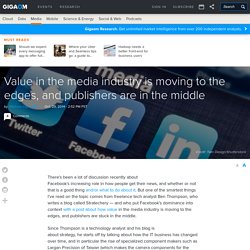
But one of the smartest things I’ve read on the topic comes from freelance tech analyst Ben Thompson, who writes a blog called Stratechery — and who put Facebook’s dominance into context with a post about how value in the media industry is moving to the edges, and publishers are stuck in the middle. Since Thompson is a technology analyst and his blog is about strategy, he starts off by talking about how the IT business has changed over time, and in particular the rise of specialized component makers such as Largan Precision of Taiwan (which makes the camera components for the iPhone).
'10 trends that news organisations should not be following' This is an extract from an article that originally appeared on labo.mediatype.be, re-published here with permission, and translated by Paul McNally.
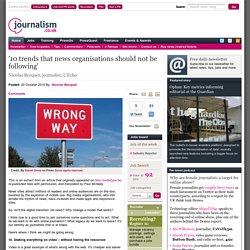
News sites attract millions of readers and online audiences are on the rise, boosted by the explosion of mobile use. News Media: Diversify or Die. InShare41.

Fungible. We don’t realize how much news media has changed in the past fifteen years.
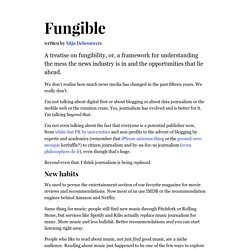
We really don’t. I’m not talking about digital first or about blogging or about data journalism or the mobile web or the curation craze. Yes, journalism has evolved and is better for it. Journalism’s biggest competitors are things that don’t even look like journalism. Ever since the web was invented, newspapers and other media entities have had to continually expand their view of who their competition is: in the good old days it was other newspapers, and then TV, and then after the web it became other news websites, or maybe Yahoo or Google.

But even now, their perspective on that competition may still be too narrow — as my friend Om has argued, they are competing with anything that captures a reader’s attention. And I would argue that they are competing with any service that fills an information need. I started thinking about this again earlier this week, when a link to an old blog post by journalist/programmer Stijn Debrouwere showed up in my Twitter stream, posted and retweeted by multiple people. Kaiser_memo.pdf. The Bad News About the News. Published 10/16/2014 In 1998, Ralph Terkowitz, a vice president of The Washington Post Co., got to know Sergey Brin and Larry Page, two young Silicon Valley entrepreneurs who were looking for backers.

Fungible. Journalism’s biggest competitors are things that don’t even look like journalism. News Media: Diversify or Die. Legacy Media: The Lost Decade In Six Charts. Ten years.
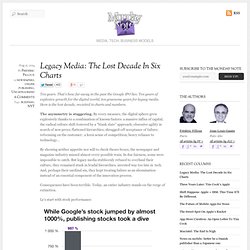
That’s how far away in the past the Google IPO lies. Ten years of explosive growth for the digital world, ten gruesome years for legacy media. Here is the lost decade, revisited in charts and numbers. The asymmetry is staggering. The Internet's Original Sin. Ron Carlson’s short story “What We Wanted To Do” takes the form of an apology from a villager who failed to protect his comrades from marauding Visigoths.
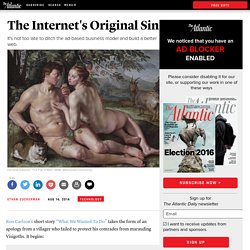
It begins: What we wanted to do was spill boiling oil onto the heads of our enemies as they attempted to bang down the gates of our village. But as everyone now knows, we had some problems, primarily technical problems, that prevented us from doing what we wanted to do the way we had hoped to do it. A New Golden Age for Media? - Justin Fox. An era of investment in the news business is upon us.
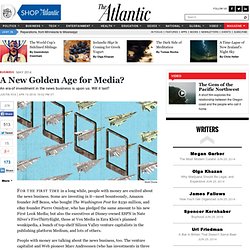
Digital disruption: Six consumer trends and what businesses need to do now. Consumer behavior is rapidly changing, with “digital” activities growing rapidly in every sphere (see text box below). In the US, 48 percent of all the video viewed is now either “time-shifted” (using DVRs or video on demand) or “device-shifted” (from television sets to laptops, tablets, or mobile phones). Music is even more digital, with just over two-thirds of usage from streaming services, MP3 files, and satellite radio, leaving traditional AM/ terrestrial FM radio with a mere 32 percent share.
A club that will have me as a member: Voice of San Diego and MinnPost are building out their membership models. About 300 people filled an event space in San Diego a couple weeks ago to take part in a discussion sponsored by Voice of San Diego on innovations with origins in the area. The assembled crowd served as a physical representation of an amorphous concept that’s on the rise in nonprofit journalism: membership.
Every single person in attendance was a paid member of Voice of San Diego, with some of them having joined in order to attend the event. The following week, the site had to rent out an entire restaurant to fit all the members who would attend its monthly coffee talk. News organizations have long tried to turn casual customers into regular ones. “To change destiny, journalists need to fundamentally rethink their business” Ben Thompson, a smart observer of the technology world (lots of interesting stuff at his blog Stratechery), has a piece up on the future of news.
It’s a useful outsider’s view of the business, and he’s right about the unsustainable nature of anything resembling the classic newspaper business model. The reason why I find business models so fascinating is because your business model is your destiny; newspapers made their bed with advertisers, and when advertisers left for a better product, the newspaper was doomed. To change destiny, journalists need to fundamentally rethink their business:— More and more journalism will be small endeavors, often with only a single writer.
The writer will have a narrow focus and be an expert in the field they cover. Presse : quelles stratégies pour augmenter les revenus ? Par Barbara Chazelle, France Télévisions, Directions Stratégie et Prospective La semaine dernière à Londres se sont tenues les Digital Media Strategies, deux jours de conférences durant lesquels les patrons de presse ont partagé expériences, échecs et convictions. Voici au moins leurs stratégies pour augmenter leurs revenus publicitaires et fidéliser leurs lecteurs. Accès en ligne gratuit ou payant ? Une table ronde opposant les CEO de News UK (The Times, The Sunday Times, The Sun), Mike Darcey et du Guardian Media Group, Andrew Miller a montré que le choix n’est toujours pas simple à faire et dévoile deux stratégies publicitaires différentes.
The Future of the News Business: A Monumental Twitter Stream All in One Place. Photo: Benben BY MARC ANDREESSEN I am more bullish about the future of the news industry over the next 20 years than almost anyone I know. You are going to see it grow 10X to 100X from where it is today. Paying for news by filling a need: Lessons from Austin’s Digital News Revenue Summit. Editor’s note: Dozens of leaders of online news organizations — for- and nonprofit — gathered recently in Austin to talk money. Here, Jake Batsell, the gathering’s organizer, distills what they discussed. Reprogramming your thermostat every time the seasons change can be a maddening exercise. But that humdrum annoyance created a market opportunity for Nest Labs, whose $249 self-programming thermostat allows users to more easily manage their personal comfort.
Content Exchanges Could Help Save the Publishing Industry. Consumers' appetite for content on a 24-hour basis is at an all-time high, and many publishers are struggling to keep up. Most are experimenting with a multitude of different strategies, from native to mobile to social and more, all in the name of earning revenue and providing readers with a constant stream of fresh, engaging content. But the fact remains that high-quality content, from in-depth articles to premium videos, is scarce. This valued content is expensive and time-consuming to do well, and in today's climate it no longer makes sense for publishers to create great content and have it live only on their own websites. All of this adds up to the need for a radical shift in how publishers do business. Newsonomics - gabrielle.boericharles - Gmail. » Why We Need the New News Environment to be Chaotic Clay Shirky. Reuters Institute Digital News Report 2014 - Full Report (low resolution)-GBC.
IM2013 ReflectionsontheDigitalWorld. Hal Varian the economics of the newspaper business Journalism Festival #ijf13. 224608514-The-Full-New-York-Times-Innovation-Report. Aggregation and Disaggregation of Information Goods. Hal Varian the economics of the newspaper business Journalism Festival #ijf13. L’écosystème des médias. Markets for Information Goods - Hal Varian. Shared Information Goods. Willingness-to-pay-for-news. Xerfi Precepta 2com15. Netflix-vs-news. Articles. University of Toulouse - Academia.edu. Born in Athens, Greece, in 1976, I received my Ph.D. in Communication and Media Studies in 2005 at the University of Grenoble, France. Currently I work at the University of Toulouse in the Laboratory of studies and applied research in social sciences (LERASS). My research and publications focus on the socioeconomic stakes and political issues of the internet.
Mediatwits #104 Special: Crowdfunding the News, Musicals, Documentaries and More. Members, fans and complementary revenue models for the New York Times. Du livre au web : de l’abonnement illimité… aux web services. Beaucoup de startups voudraient devenir le Netflix ou le Spotify du livre électronique, c'est-à-dire proposer un abonnement illimité à un vaste catalogue de livres comme le propose Netflix pour la vidéo ou Spotify pour la musique… Reste que ce n'est pas si simple, notamment parce qu'il faut réussir avant tout à négocier un catalogue de titres conséquents pour réussir à attirer des abonnés. » How newspapers blew it in the mid-1990s JIMROMENESKO. Debunking the “original sin” of online newspapers.
The newsonomics of the surprisingly persistent appeal of newsprint. The newsonomics of majority reader revenue. Newsonomics - How the emerging business of digital news shapes what we read and know. The Newsonomics of Apple’s/Google’s/Press+’s Pay-for-All. Why news is a fungible commodity, and why that matters - John Kroll Digital. When Selling Digital Content, Let the Customer Set the Price - Marco Bertini , and Richard Reisman. The FairPay Zone: HBR Blog Post on FairPay: "When Selling Digital Content, Let the Customer Set the Price" FairPay: Customer Dialogs about Value. The FairPay Zone: FairPay: "Better Strategies for Monetizing Digital Offerings" MIT Enterprise Forum 12/1/11. EF-NYC: Better Strategies for Monetizing Digital Offerings. The FairPay Zone: "Why should I pay you?" - Bezos' Washington Post - Mapping a New Business Model for Journalism. The FairPay Zone: Pierre Omidyar: Adventures in New Business Models for Journalism ...and FairPay.
The FairPay Zone: Paywall 2.0 ...and Paywall 3.0. The FairPay Zone: FairPay for The Times?...for JournalismOnline newspapers?...or Google Newspass? Zuora CEO on doing paywall 2.0 right - video. Paywall 2.0 The Reinvention Of Media. Rebuilding mass media: Do we really want or need a digital version of the old Time Inc.? Are newspapers losing ‘mass media’ mojo? Changing Business of Journalism Exec Summary - Changing_Business_of_Journalism_Exec_Summary.pdf. Paid digital content: The journey begins. US journalism makes break with market forces. Manifeste pour une presse numérique payante. Clay Shirky: Let a thousand flowers bloom to replace newspapers; don’t build a paywall around a public good. Yes, some people will pay you for your news — a really, really small number of people. Hal Varian: the economics of the newspaper business. Marc Andreessen talks about the evolution of the news business and why he is optimistic.
We Are Googling the New York Times to Death. More people around the world are getting news on phones, but paying for it is still rare. Unlocking mobile revenue and audience: New ideas and best practices. European newspapers search for ways to survive digital revolution. Everything you need to know about the future of newspapers is in these two charts. The newsonomics of the print orphanage — Tribune’s and Time Inc.’s. Sell the news, give away the olds. The Future of the News Business: A Monumental Twitter Stream All in One Place. At New York Times, 65% of digital-only subscribers are ‘entirely new’ The story as gateway to knowledge (and revenue) The newsonomics of Spotified news subscriptions. Content economics, part 2: payments.
Content economics, part 5: news. Stock and flow in 18th-century Paris: The longstanding art of smartly curating content.